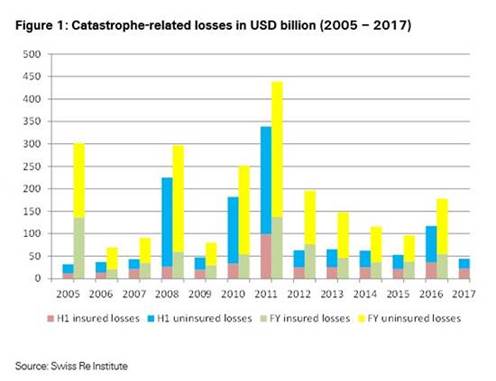According to preliminary sigma estimates, global total economic losses from natural catastrophes and man-made disasters in the first half of 2017 were $44 billion. That was well below the first half annual average of $120 billion of the last 10 years in economic losses and significantly lower than the same period a year ago. Of the total losses in the first half 2017, $23 billion were covered by insurance. A series of severe thunderstorms in the US caused some of the largest losses in the first half of 2017. Globally, around 4,400 people lost their lives or went missing in disaster events, compared with 4,800 in the first six months of 2016.
Out of the $44 billion total global economic losses, natural catastrophes alone accounted for $41 billion in the first half of 2017, compared with $110 billion in H1 2016, while the remaining $3 billion came from man-made disasters. Global insured losses from natural catastrophes fell to $20 billion from $30 billion the year before, while insured losses from man-made disasters were $3 billion, down from $6 billion. The number of victims of disaster events was around 4,400. That is low relative to recent years, but the toll may rise once estimates on the number of victims of Europe’s severe June heat waves are included.
Biggest losses from thunderstorms in the US – most of them covered by insurance
Severe convective storms (thunderstorms) in the U.S. resulted in the largest losses in the first six months of this year. Four separate severe weather events from February to May each caused insured losses of more than S1 billion. The most intense and costly event was a four-day long storm in May with heavy damage to property inflicted by hail in Colorado and strong winds in other parts of southern and central states. The economic losses of this storm alone were $2.2 billion, with insured losses of $1.9 billion.
A high number of smaller storms and other weather events (like floods) in the US in the first six months of 2017 led to insured losses of around $16 billion out of the overall $23 billion in insured losses. “Fortunately, in the US, most households and businesses are insured against wind risk so they are financially protected when severe storms strike,” said Swiss Re’s Chief Economist Kurt Karl.
A year of weather extremes
The largest and most costly insurance event outside of the US was Cyclone Debbie, a category 4 tropical cyclone that hit the northeastern coast of Australia in late March. Wind gusts of up to 263 km/h and widespread flooding in central and southeast Queensland and northeast New South Wales during the following days led to insured losses of $1.3 billion.
Other large events included floods in Peru, and severe frost damage in late spring in the southeastern part of the US and in Europe. At the beginning of the year, there was also a cold spell throughout Europe that claimed dozens of hypothermia victims. This was followed by a summer of heat waves and record temperatures in several European locations, making 2017 so far a year of weather extremes. High temperatures and dry weather have continued through the northern hemisphere’s summer season, igniting wildfires in many parts of the world.
Source: Swiss Re
Was this article valuable?
Here are more articles you may enjoy.


 Tricolor Trustee Plans to Sue Founder for Auto Dealer’s Collapse
Tricolor Trustee Plans to Sue Founder for Auto Dealer’s Collapse  Zillow Deleting Climate Risk Scores Reveals Limits of Flood, Fire Data
Zillow Deleting Climate Risk Scores Reveals Limits of Flood, Fire Data  Abbott Presses Congress for Shield Over Preemie Baby Formula Litigation That Could Cost It Billions
Abbott Presses Congress for Shield Over Preemie Baby Formula Litigation That Could Cost It Billions  Verlan Files Subro Suit Against Georgia Chemical Plant After $20M Payout on Fire
Verlan Files Subro Suit Against Georgia Chemical Plant After $20M Payout on Fire 